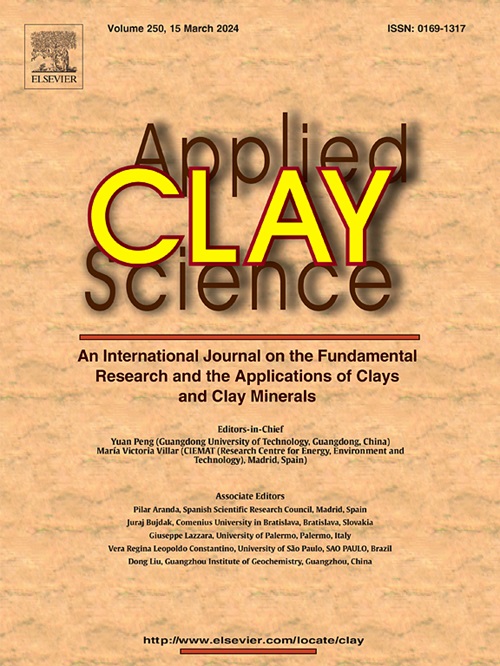Optimization of zeolite LTA formation from kaolin using fusion/hydrothermal method: Crystallization parameters and Box-Behnken experimental design
IF 5.8
2区 地球科学
Q2 CHEMISTRY, PHYSICAL
引用次数: 0
Abstract
Using the fusion/hydrothermal approach, the effects of NaOH/kaolin ratio, the crystallization temperature and the crystallization time of the reaction system on the synthesis of zeolite A from natural kaolin have been methodically investigated. The study aimed to enhance crystallinity of the obtained zeolite by employing optimization curves generated from a three-level Box-Behnken Design (BBD) simulation. Using XRD, SEM/EDS, FTIR, XPS and TEM/SAED, the synthesis products' phase, composition and morphology were described. The morphological analysis and elemental characterization confirm that the NaOH/kaolin treated at 550 °C has the necessary Si/Al ratio and structural transformation to support LTA zeolite synthesis. The XRD analysis reveals that optimal conditions for synthesizing high-purity Zeolite A include a NaOH concentration of 3 M, 5 h of agitation, 12 h of crystallization, and a crystallization temperature of 90 °C. Higher NaOH concentrations and crystallization temperatures can lead to unwanted phases like sodalite, while longer times do not significantly improve crystallinity. From the statistical results, the optimal conditions identified 90 °C, a NaOH/kaolin weight ratio of 0.9, and a crystallization duration of 12.50 h resulted in a significant increase in crystallinity, reaching 88.60 %. These findings underscore the importance of carefully controlling synthesis parameters to achieve high-quality zeolite products through the fusion/hydrothermal process. In addition, the validation of the response surface methodology (RSM) model confirmed its effectiveness in optimizing the synthesis parameters for Zeolite A, achieving a crystallinity of 91.10 % under the ideal conditions of a NaOH/kaolin weight ratio of 1.06, crystallization temperature of 92.99 °C, and crystallization time of 12.69 h. The results, supported by SEM analysis, demonstrated improved crystallinity and uniform particle size, aligning closely with predicted values. This successful validation emphasizes the model's reliability and potential for enhancing production efficiency while maintaining high-quality zeolite A. Its economic viability for industrial-scale applications was demonstrated by the projected $0.95/kg cost of producing zeolite A from Algerian kaolin using the fusion/hydrothermal technique.

熔融/水热法制备高岭土沸石LTA的优化:结晶参数和Box-Behnken实验设计
采用熔融/水热法,系统研究了NaOH/高岭土比、结晶温度和结晶时间对天然高岭土合成A型沸石的影响。该研究旨在通过采用三层Box-Behnken设计(BBD)模拟生成的优化曲线来提高所得沸石的结晶度。采用XRD、SEM/EDS、FTIR、XPS和TEM/SAED对合成产物的物相、组成和形貌进行了表征。形态分析和元素表征证实,550℃处理的NaOH/高岭土具有支持LTA分子筛合成所需的Si/Al比和结构转变。XRD分析表明,合成高纯度A沸石的最佳条件为:NaOH浓度为3 M,搅拌5 h,结晶12 h,结晶温度为90℃。较高的NaOH浓度和结晶温度会导致不需要的相,如钠石,而较长的时间并不能显着提高结晶度。从统计结果来看,最佳条件为90℃,NaOH/高岭土质量比为0.9,结晶时间为12.50 h,结晶度显著提高,达到88.60%。这些发现强调了仔细控制合成参数以通过熔融/水热工艺获得高质量沸石产品的重要性。此外,响应面法(RSM)模型验证了其在优化A型沸石合成参数方面的有效性,在NaOH/高岭土质量比为1.06、结晶温度为92.99℃、结晶时间为12.69 h的理想条件下,A型沸石的结晶度为91.10%。SEM分析结果表明,A型沸石的结晶度有所提高,粒径均匀,与预测值基本一致。这一成功的验证强调了该模型的可靠性和在保持高质量A型沸石的同时提高生产效率的潜力。通过使用融合/热液技术从阿尔及利亚高岭土中生产A型沸石的预计成本为0.95美元/公斤,证明了该模型在工业规模应用中的经济可行性。
本文章由计算机程序翻译,如有差异,请以英文原文为准。
求助全文
约1分钟内获得全文
求助全文
来源期刊

Applied Clay Science
地学-矿物学
CiteScore
10.30
自引率
10.70%
发文量
289
审稿时长
39 days
期刊介绍:
Applied Clay Science aims to be an international journal attracting high quality scientific papers on clays and clay minerals, including research papers, reviews, and technical notes. The journal covers typical subjects of Fundamental and Applied Clay Science such as:
• Synthesis and purification
• Structural, crystallographic and mineralogical properties of clays and clay minerals
• Thermal properties of clays and clay minerals
• Physico-chemical properties including i) surface and interface properties; ii) thermodynamic properties; iii) mechanical properties
• Interaction with water, with polar and apolar molecules
• Colloidal properties and rheology
• Adsorption, Intercalation, Ionic exchange
• Genesis and deposits of clay minerals
• Geology and geochemistry of clays
• Modification of clays and clay minerals properties by thermal and physical treatments
• Modification by chemical treatments with organic and inorganic molecules(organoclays, pillared clays)
• Modification by biological microorganisms. etc...
 求助内容:
求助内容: 应助结果提醒方式:
应助结果提醒方式:


